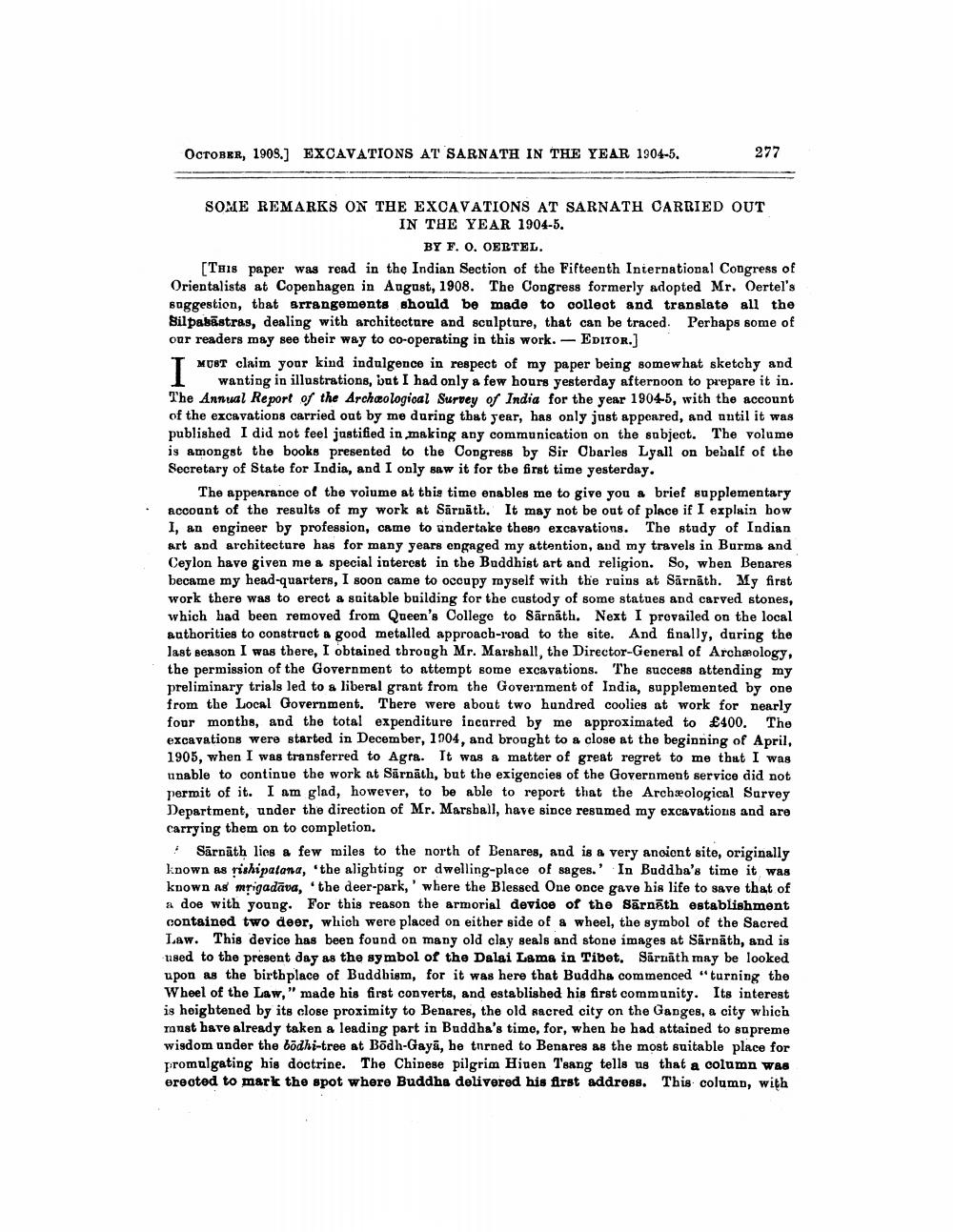________________
OCTOBER, 1908.) EXCAVATIONS AT SARNATH IN THE YEAR 1904-5,
277
SOME REMARKS ON THE EXCAVATIONS AT SARNATH CARRIED OUT
IN THE YEAR 1904-5.
BY F. O. OERTEL. Tuis paper was read in the Indian Section of the Fifteenth International Congress of Orientalists at Copenhagen in August, 1908. The Congress formerly adopted Mr. Oertel's soggestion, that arrangements should be made to colleot and translate all the Silpabāstras, dealing with architecture and sculpture, that can be traced. Perhaps some of our readers may see their way to co-operating in this work. - EDITOR.] T most claim your kind indulgence in respect of my paper being somewhat sketchy and I wanting in illustrations, but I had only a few hours yesterday afternoon to prepare it in. The Annual Report of the Archaological Survey of India for the year 1904-5, with the account of the excavations carried out by me during that year, has only just appeared, and until it was published I did not feel justified in making any communication on the subject. The volume is amongst the books presented to the Congress by Sir Obarles Lyall on bebalf of the Secretary of State for India, and I only saw it for the first time yesterday.
The appearance of the volume at this time enables me to give you a brief supplementary account of the results of my work at Särnăth. It may not be out of place if I explain bow I, an engineer by profession, came to andertake theon excavations. The study of Indian art and architecture has for many years engaged my attention, and my travels in Burma and Ceylon have given me a special interest in the Buddhist art and religion. So, when Benares became my head-quarters, I soon came to occupy myself with the ruins at Sārnāth. My first work there was to erect a suitable building for the custody of some statues and carved stones, which had been removed from Queen's College to Sārnāth. Next I prevailed on the local authorities to construct a good metalled approach-road to the site. And finally, during the last season I was there, I obtained through Mr. Marshall, the Director-General of Archæology, the permission of the Government to attempt some excavations. The success attending my preliminary trials led to a liberal grant from the Government of India, supplemented by one from the Local Government. There were about two hundred coolics at work for nearly four months, and the total expenditure incarred by me approximated to £400. The excavations were started in December, 1904, and brought to a close at the beginning of April, 1905, when I was transferred to Agra. It was a matter of great regret to me that I was unable to continue the work at Sārnāth, but the exigencies of the Government service did not permit of it. I am glad, however, to be able to report that the Archaeological Survey Department, under the direction of Mr. Marsball, have since resumed my excavations and are carrying them on to completion.
Sārnath lies a few miles to the north of Benares, and is a very anoiont site, originally known as rishipatana, 'the alighting or dwelling-place of sages.' In Buddha's time it was known as mrigadāva, the deer-park,' where the Blessed One once gave his life to save that of a doe with young. For this reason the armorial device of the Sārnāth establishment contained two deer, which were placed on either side of a wheel, the symbol of the Sacred Law. This device has been found on many old clay seals and stone images at Sārnāth, and is used to the present day as the symbol of the Dalai Lama in Tibet. Särnāth may be looked upon as the birthplace of Buddhism, for it was here that Buddha commenced "turning the Wheel of the Law," made his first converts, and established his first community. Its interest is heightened by its close proximity to Benares, the old Racred city on the Ganges, a city which monst have already taken a leading part in Buddha's time, for, when he had attained to sapreme wisdom under the bodhi-tree at Bödh-Gaya, be turned to Benares as the most suitable place for promulgating his doctrine. The Chinese pilgrim Hiuen Tsang tells us that a column was erected to mark the spot where Buddha delivered his first address. This column, with




